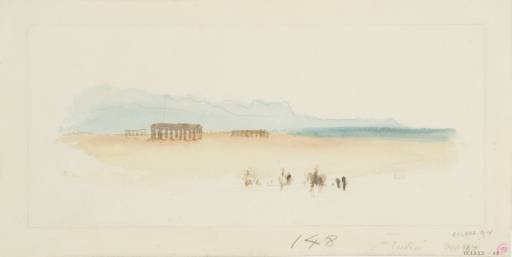Joseph Mallord William Turner Study for 'Temples of Paestum', Rogers's 'Italy' c.1826-7
Joseph Mallord William Turner,
Study for 'Temples of Paestum', Rogers's 'Italy'
c.1826-7
Joseph Mallord William Turner 1775–1851
Study for ‘Temples of Paestum’, Rogers’s ‘Italy’ circa 1826–7
D27609
Turner Bequest CCLXXX 92
Turner Bequest CCLXXX 92
Pencil and watercolour, approximately 62 x 203 mm on white wove paper, 131 x 258 mm
Inscribed by John Ruskin in red ink ‘(92’ bottom right
Inscribed by unknown hands in pencil ‘148’ bottom centre and ‘CCLXXX 92’ lower right and ‘Paestum’ and ‘Oxford 98 x’ bottom right. Also ruled pencil lines on all four sides of vignette
Stamped in black ‘CCLXXX–92’ bottom right
Inscribed by John Ruskin in red ink ‘(92’ bottom right
Inscribed by unknown hands in pencil ‘148’ bottom centre and ‘CCLXXX 92’ lower right and ‘Paestum’ and ‘Oxford 98 x’ bottom right. Also ruled pencil lines on all four sides of vignette
Stamped in black ‘CCLXXX–92’ bottom right
Accepted by the nation as part of the Turner Bequest 1856
Exhibition history
1878
[Oxford Loan Collection], University of Oxford, 1878–1916 (131 and 98).
1974
Turner and Watercolour: An Exhibition of Watercolours Lent from the Turner Bequest at the British Museum, Arts Council tour, Herbert Art Gallery & Museum, Coventry, April 1974, Graves Art Gallery, Sheffield, May 1974, Castle Museum, Norwich, June 1974, City Art Gallery, Leeds, June–July 1974, City Art Gallery, Bristol, July–August 1974, Towner Art Gallery, Eastbourne, August–September 1974 (30, reproduced as ‘Paestum’).
1993
Turner’s Vignettes, Tate Gallery, London 1993 (6, reproduced).
References
1878
Catalogue of Sketches by Turner Lent by The Trustees of the National Gallery to the Ruskin Drawing School, Oxford, London 1878, nos.131 (1st edition), 98 (2nd edition), as ‘Paestum’.
1909
A.J. Finberg, A Complete Inventory of the Drawings in the Turner Bequest, London 1909, vol.II, p.895, as ‘Paestum’.
1974
John Gage, Turner and Watercolour: An Exhibition of Watercolours Lent from the Turner Bequest at the British Museum, exhibition catalogue, Herbert Art Gallery & Museum, Coventry 1974, no.30, p.35, reproduced as ‘Paestum’.
1983
Cecilia Powell, ‘Turner’s vignettes and the making of Rogers’s “Italy” ’, Turner Studies, vol.3, no.1, Summer 1983, pp.6, 13 note 60.
1984
Cecilia Powell, ‘Turner on Classic Ground: His Visits to Central and Southern Italy and Related Paintings and Drawings’, unpublished Ph.D thesis, Courtauld Institute of Art, University of London 1984, p.519 note 56.
1993
Jan Piggott, Turner’s Vignettes, exhibition catalogue, Tate Gallery, London 1993, no.6, pp.82 reproduced, 96.
This is a preparatory watercolour study for the head-piece of the section entitled ‘Paestum’ in Rogers’s Italy. A second and very different version of this subject was engraved and published in Italy (see Tate, D27665; Turner Bequest, CCLXXX 148). The three fifth-century Doric Greek temples at Paestum had been rediscovered in the mid eighteenth century and the site soon became a well-known destination for English travellers on the Grand Tour.1 It was the southernmost point of Turner’s own tour of Italy in 1819–20. During his travels Turner produced numerous sketches of the temples at Paestum (see Tate, D15945–6, D15967–73, D15980, D15995–7; Turner Bequest, CLXXXVI 19a–19b, 28a–31a, 35, 42a–43a). The composition for the image is clearly derived from several sketches that Turner made while at Paestum (see Tate, D15946, D15968; Turner Bequest, CLXXXVI 19 b, 29). These drawings would later serve as models for the background in Story of Apollo and Daphne, exhibited at the Royal Academy in 1837 (Tate, N00520).2
The watercolour vignette study shows that Turner first considered depicting all three of the temples in clear weather and from a significant distance. It seems to derive from a different set of verses than those which Turner chose to illustrate in his final version of Paestum. In an earlier section of the poem, Rogers describes how:
The air is sweet with violets, running wild
Mid broken friezes and fallen capitals;
...
as alone I stand
In this, the nobler pile, the elements
Of earth and air its only floor and covering,
How solemn is the stillness!
(Italy, p.209)
Mid broken friezes and fallen capitals;
...
as alone I stand
In this, the nobler pile, the elements
Of earth and air its only floor and covering,
How solemn is the stillness!
(Italy, p.209)
Although the forms of the temples and the surrounding mountains are only slightly indicated, Turner’s scene powerfully evokes the peaceful and tranquil mood that Rogers describes above. The light washes that define the areas of water, sand, and sky seem to be inspired by Rogers’s description of the ancient temples with ‘earth and air its only floor and covering’. Although Cecilia Powell has described the study and final version of Paestum as being ‘close in substance and feeling’, it is important to note the very different moods and compositions of these two works.3 The existence of these two divergent designs clearly indicates that Turner paid close attention to Rogers’s text when deciding which verses to highlight in his illustrations.
Verso:
Blank
Meredith Gamer
August 2006
How to cite
Meredith Gamer, ‘Study for ‘Temples of Paestum’, Rogers’s ‘Italy’ c.1826–7 by Joseph Mallord William Turner’, catalogue entry, August 2006, in David Blayney Brown (ed.), J.M.W. Turner: Sketchbooks, Drawings and Watercolours, Tate Research Publication, December 2012, https://www

